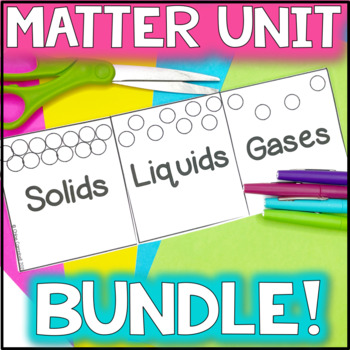Solids, liquids, gases, mass, volume, color, texture, temperature, magnetism, oh my! Teaching about the states of matter and properties of matter is no easy task. But . . . I’m here to tell you that this topic is perfect for engaging, hands on activities. Including hands on activities for states of matter transformed my unit from blah to aha for my students, and they can work for you too!

Teaching Matter can be fun and Engaging
Sure, there is a ton of vocabulary you have to cover, but once your students have a solid foundation (pun intended!), there is a world of possibilities when it comes to states of matter investigations and experiments.
I have found that using hands on experiments really gets my kids excited about their learning, so you better believe I will use them as much as possible.
Hands on activities can make your teacher life so much easier. Here are three simple yet effective hands on activities for states of matter that I love using in my classroom!
#1: Properties of Matter Investigation
After a lesson on the physical properties of matter, I love having my students participate in properties of matter investigation to reinforce the concepts. I have found that there is no better way for them to connect reality to vocabulary than to just apply it. This low prep investigation will help students apply their new states of matter properties of matter vocabulary in a very real way.
Students get to choose 5 objects or you can assign them specific objects to explore. Once students have their objects, they observe and measure each of them.
Then they record the following for each object:
- State of matter
- Mass
- Volume
- Color
- Texture
- Temperature
- Magnetism
This helps them to see the concepts first hand making vocabulary acquisition much more successful!
Don’t have time to prep your own properties of matter investigation? You can grab one in my Teachers Pay Teachers store that is ready to go for you!
#2: Separation of Solid Mixtures Investigation
If your science standards include language around separating solid mixtures, then I have the perfect hands-on investigation to help your students reach the benchmark! Since the concept of separating mixtures can be a difficult one for students to understand, I use 6 mini separation activities as part of this investigation. Students will rotate through the 6 activities and they are challenged at each one to separate a mixture.
Through these 6 separation activities students will see how different tools are helpful in the separation process. They also learn that not all things are easy to separate. It’s fun and challenging investigation that really puts them right in the middle of the concept.
This investigation can be completed individually, as a whole group, or in small groups.
Your students will love separating things like:
- Small rocks from sand
- Salt from pepper
- Paperclips from erasers
Each card asks students to separate a certain set of materials and then reflect on which property they used in order to separate the materials. You can do a quick check for understanding with the included exit slips too!
I’ve found this is a great way to get students engaged with a topic that might not otherwise be very interesting to them.
It is definitely one of my top picks when choosing hands on activities for my states of matter unit!
#3: What Dissolves in Water Experiment
When I first started teaching states of matter and properties of matter, my students struggled with the concept of solubility. This experiment that includes simple household objects was a game changer!
I give students several cups with warm water and a variety of items to test. Before we begin, students predict if the item will dissolve in the water. Then they complete the investigation to find out.
Many of these supplies, you probably already have on hand in the science lab. If not, this is a great opportunity to ask parents to send in some of the supplies you will need. Parents are always looking for ways to help, they just need to be asked.
Once the students start the experiment, they record their observations and make a final determination if the item dissolved or not.
It’s a great way to get your students predicting what will happen and then checking their hypothesis at the end of the experiment.
It’s always fun for me to hear the shouts of excitement when something doesn’t go the way my students expect.
If you are looking for a made-for-you recording sheet with materials and directions for this experiment, you can find one in this Dissolving and Solubility Packet.
Teaching the States of Matter Resource
Teaching the states of matter becomes infinitely more exciting when including hands on activities! Students love the ability to manipulate materials and explore the concepts firsthand.
It’s surprising to think that hands-on, group activities could lead to more student engagement, but it does!
I love watching my students work collaboratively to complete their experiments. It’s a great opportunity to get your students to participate in some really amazing discussions about their experiments and investigations.
Everything You Need for Teaching States of Matter
If you need some help putting together your states of matter unit, I have pulled together 7 of my favorite resources to create a complete States of Matter Experiments and Activities Bundle.
This bundle includes everything you need to teach states of matter including properties of matter and changing states in one place. These easy-to-print and prep lessons will engage your students with hands-on, highly engaging experiments and activities that are standards-based and planned out for you!
SAVE THESE ACTIVITIES FOR TEACHING MATTER
Love these activities for teaching matter? Save them to your favorite Pinterest teacher board and be sure to follow me for more upper elementary teaching ideas!








Leave a Reply